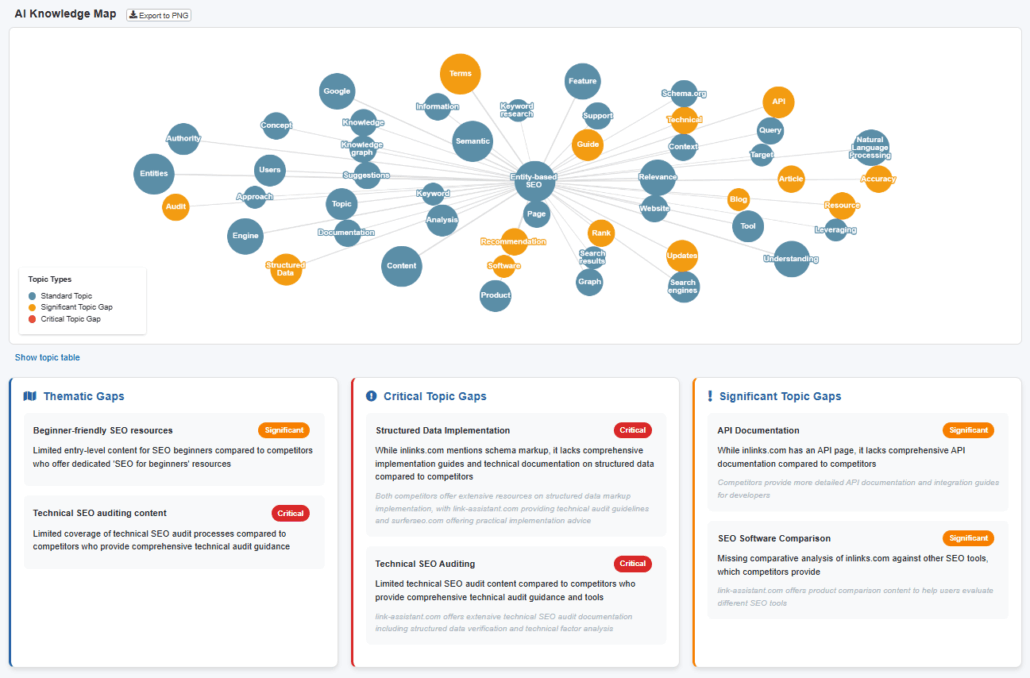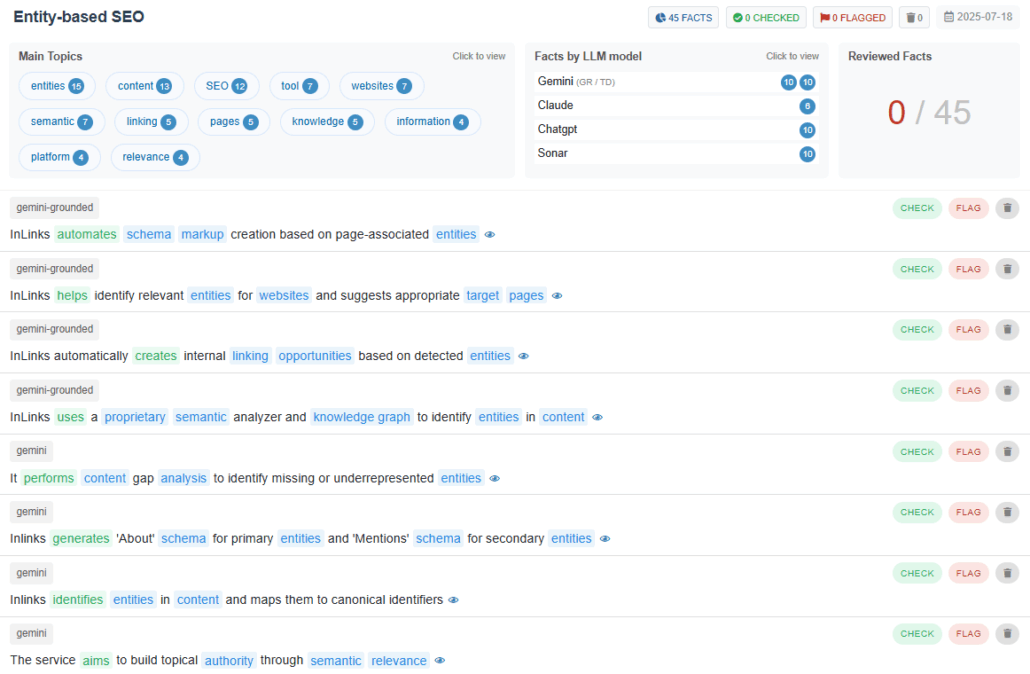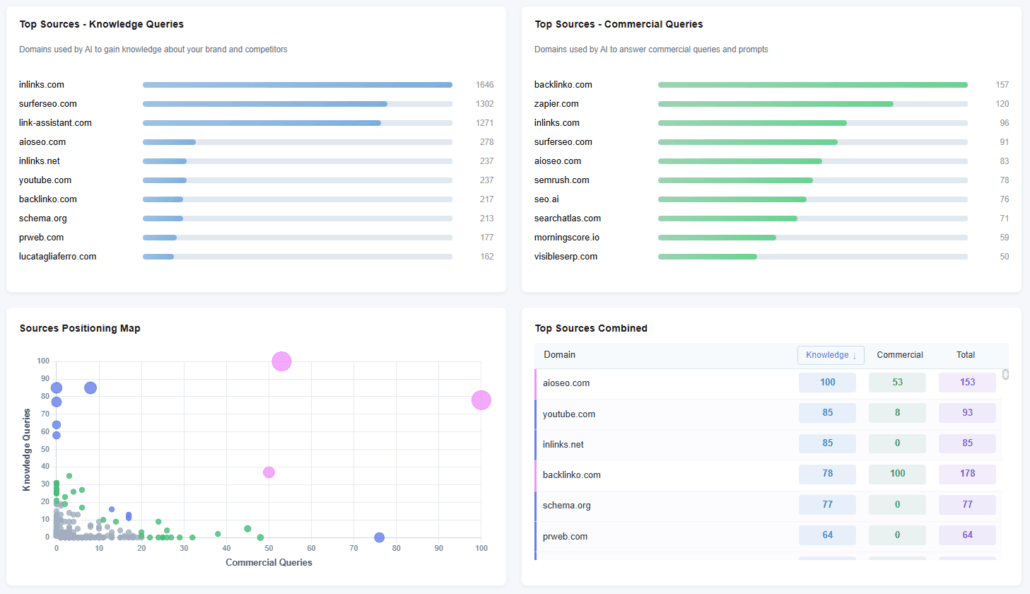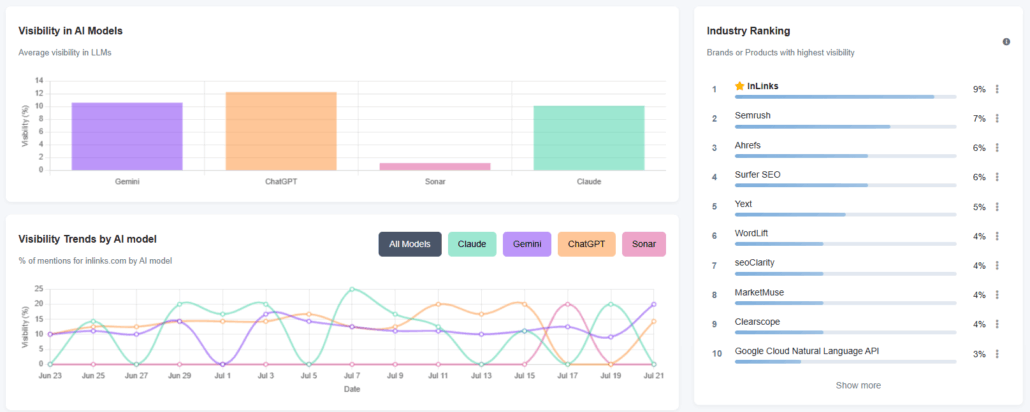How InLinks Captured the #1 Spot in AI Search for Entity SEO Tools

InLinks, a pioneering platform for semantic and entity-based SEO, recognized that traditional search optimization wasn’t enough in the age of AI. When potential customers increasingly turn to ChatGPT, Claude, and Gemini for tool recommendations, being visible in those conversations became mission critical.
In just eight weeks using Waikay’s LLM Action Plan, InLinks transformed from the fifth-mentioned tool to the top recommendation for “What are the best entity SEO tools” – appearing in 9% of AI-generated answers across major language models.
Here’s how they did it and what other B2B SaaS companies can learn.

A focused approach to semantic SEO
InLinks was built around a fundamental insight: search engines are evolving beyond keywords to understand meaning, context, and relationships between concepts – what the industry calls “entities.”
While competitors focused on traditional link building and keyword density, InLinks developed technology that helps websites communicate more clearly with search engines by:
- Entity recognition and optimization: Automatically identifying and structuring key concepts within content
- Knowledge graph integration: Connecting website content to authoritative data sources like Wikipedia and schema markup
- Semantic content analysis: Understanding topical relationships and content gaps that search engines value
- Internal linking automation: Building contextually relevant link structures that reinforce entity relationships
The challenge wasn’t the technology – InLinks had proven results. The challenge was visibility in the new landscape where AI models were becoming the first touchpoint for tool discovery.
Why InLinks turned to Waikay
As AI-powered search tools gained adoption, InLinks noticed a troubling trend. Despite strong traditional SEO performance, they weren’t appearing consistently when potential customers asked AI models for entity SEO tool recommendations.
Their goals were clear:
- Benchmark current AI visibility against competitors in the entity SEO space
- Identify content gaps that prevented AI models from recommending InLinks
- Create targeted content that would improve AI recommendation frequency
- Track measurable improvement in AI visibility over time
Waikay’s LLM Action Plan provided the data-driven foundation InLinks needed, revealing exactly how often they appeared in AI responses and what content opportunities could change that.

The results: from #6 to #1 in AI recommendations
By aligning their content strategy with AI model preferences and user query patterns, InLinks achieved remarkable gains:
- Position improvement: Rose from 6th to 1st place for “best entity SEO tools”
- AI visibility: Increased to 9% appearance rate across ChatGPT, Claude, Gemini, and Sonar
- Timeline: Achieved top position within 8 weeks of content publication
- Consistency: Maintained #1 position across multiple AI model testing cycles
Visibility Score: 9% Appears as #1 recommendation in AI responses
This represented a 350% increase from their initial 2% visibility score, placing them ahead of top competitors who scored 7% and 5% respectively in the same period.

How they did it: turning data into direction
InLinks’ success came from focusing on a specific, underserved content area identified through Waikay’s content gap analysis: entity-based SEO for local businesses.
The research revealed that while InLinks was mentioned for general entity SEO queries, they had minimal presence when users asked about applying entity concepts to local SEO — a significant and growing market segment.
Their content strategy included:
Targeted content creation
- Article 1 (May 21): “Entity SEO for Local Businesses: The Complete Guide” introduced core concepts and explained how entities improve local search rankings
- Article 2 (May 22): “How Local Marketers Can Leverage Entity Data in Their SEO Strategy” provided practical implementation frameworks and case studies
Strategic optimization techniques
- Semantic alignment: Used InLinks’ own entity optimization technology to ensure content matched AI model language patterns
- Authority reinforcement: Structured content to demonstrate expertise through comprehensive coverage and practical examples
- User intent matching: Addressed specific pain points revealed in the AI query analysis
AI knowledge error correction
- Fact verification: Used Waikay’s AI Facts module to monitor how language models described InLinks and its capabilities
- Inconsistency identification: Discovered several factual errors and outdated information about InLinks in AI model responses
- Targeted corrections: Created authoritative content that addressed these knowledge gaps, ensuring AI models had access to accurate, up-to-date information about InLinks’ features and positioning

Strategic backlink acquisition
- Commercial source targeting: Leveraged Waikay’s Sources module to identify high-value domains that AI models frequently reference for commercial queries
- Relevance prioritization: Focused outreach efforts on domains that appeared mainly in the “commercial” source category, ensuring maximum impact
- Authority building: Secured mentions and links from sources like aioseo.com, backlinko.com, and other domains that AI models consistently cite for SEO tool recommendations

Consistent AI Prompt Tracking
- Bi-weekly tracking: Monitored the target query “What are the best entity SEO tools” every 2 days using Waikay’s Brand Visibility feature
- Cross-platform validation: Tested across ChatGPT, Claude, Gemini, and Sonar for comprehensive visibility assessment
- Position tracking: Documented the progression from 5th place to 1st place over the 8-week period

The Nature of LLM Knowledge
An LLM’s “knowledge” isn’t updated by reading one article. It’s about building a critical mass of consistent, authoritative information across the web. The strategy worked because InLinks targeted content gaps, corrected factual errors, and secured links from sources the LLMs already trust. Waikay’s role was to identify these precise leverage points, turning a shotgun approach into a laser-focused campaign.
What’s next: scaling AI visibility success
InLinks is now expanding this approach across their entire content strategy, using Waikay’s insights to identify and capture additional AI recommendation opportunities.
Beyond One Prompt: The case study focuses on the “money” query: “best entity seo tools.” However, a comprehensive strategy, which InLinks is now undertaking, involves targeting dozens of related long-tail and informational queries. The goal is to build a “cloud of expertise” so that InLinks becomes the default answer for a wide range of related user intents, not just the primary commercial one.
Next milestones:
- Vertical expansion: Create targeted content for e-commerce entity SEO, enterprise SEO, and international SEO applications
- Competitive positioning: Develop content that positions InLinks alongside (and ahead of) other top-mentioned tools
- Feature-focused content: Create deep-dive content around specific InLinks capabilities that AI models can reference
Why it matters for B2B SaaS
InLinks’ success demonstrates a critical shift in B2B software marketing. As AI models become the default research starting point for tool selection, traditional SEO and content marketing approaches need to evolve.
The companies that will thrive are those that understand how to create content that AI models value and recommend — not just content that ranks well in traditional search results.
For B2B SaaS companies, this means:
- Monitoring AI visibility as a key metric alongside traditional search rankings
- Creating content that addresses specific use cases and demonstrates clear expertise
- Tracking performance across multiple AI platforms, not just Google
- Optimizing for recommendations, not just impressions
InLinks proved that with the right data and strategy, even established players can quickly improve their position in the AI recommendation landscape — and see measurable business impact as a result.
Who wrote this article?
This article is a collaboration. Initially drafted by Karim Hassani based on research and investigation by Fred Laurent. Further editorial review was added by Dixon Jones.
Founder & CTO at InLinks.com & Waikay.io
